A long-term warming trend is raising the potential suitability for fruit crop agriculture extending north beyond the Okanagan Valley.
Growing cherries in the Shuswap or apples in the Cariboo are concepts nobody would have considered 20 or 30 years ago.
But today, climate change is raising the potential for new growing regions to extend north beyond the Okanagan Valley, says Denise Nielsen, a research scientist with the Summerland Agriculture and Research Centre for Agriculture and Agri-Food Canada.
Nielsen, a Penticton resident who retired this month, along with co-worker Istvan Losso completed a study this past year called Climate Change—Implications for Crop Suitability.
For the purposes of the study, their theories were based on the sustainability of sweet cherry crops which have an early bloom, are moderately hardy and have a short growing season.
The study showed that there is potential for fruit growing operations due to climate changes predicted projections over the next 20 years in the North Okanagan-Shuswap. Specific areas targetted are north and south of Salmon Arm near access to water and land with less than a 30 per cent slope.
Related: Promoting sustainable agriculture
Nielsen said it’s one thing for land suitability to make fruit growing potential extend north of the Okanagan Valley, but to make it a thriving industry will require infrastructure support and access to water. There is also the issue of land use evolving from cattle ranching and other crops to fruit growing.
She said there was a fruit crop industry around Kamloops prior to the Second World War, but it was frozen out by repeatedly harsh winters.
“The use of agriculture land is still a decision of a private venture or business. I tend to think of farmers as business people. The Agriculture Land Reserve preserves the land for farm use, but what agriculture is practiced on that land is still a private decision,” Nielsen said.
“So it’s not a question whether this kind of change would annoy cattle ranchers, but what makes for the best business model. If it’s more profitable to grow fruits, you will start to see ranches sold and turned into tree fruit orchards.
“We’ve already seen that impact in the Okanagan where farmers are converting hay-fields into orchards. The economics of making a living is how these things happen.”
Nielsen said their study projections see potential for fruit crop growth for those areas close to water, with cherries offering a shorter growth season while apples tend to be heartier against changing weather patterns.
Climate is one of three factors that Nielsen says contributed to the growth of the grape growing industry in the Okanagan.
Related: Growing innovation for B.C.’s agriculture industry
She said warming winters were more favourable to grape growing and the NAFTA agreement signed in 1988 raised the potential for cheaper California wines to flood the B.C. market. That caused winemakers to switch to European-influenced grapes to produce a higher quality wine which generated higher revenues and off-set the cost of land.
“The grape growing industry attracts a lot of people who seek out that kind of agriculture lifestyle, but it also brings in a lot of people willing to invest a lot of money to produce wine,” she said.
“There is a saying that if you want to make a million dollars in the wine industry, you have to put in two million dollars to get that return.”
But whether or not that industry spreads north will be reliant on the temperature, which Nielsen says no longer delivers the expectations of past 100-year trends.
“Where farmers used to depend on certain things to usually happen at certain times of the year regarding weather, those expectations have started to go awry. It means having to adjust and it means impacting their bottom line,” Nielsen said.
She said fruit tree flower buds have an ability to harden to survive cold winters, but when the temperature fluctuates wildly, it causes the bud to soften and then harden again.
“What that threshold is when a flower bud can no longer repeat that process is something we continue to do research on,” she said.




